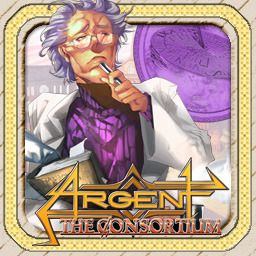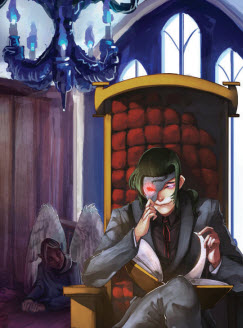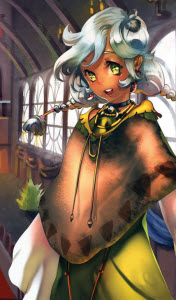Argent: The Consortium is a new twist on an old genre. It’s a worker placement game (well, wizard-placement), but with the variation and thematic elements typically associated with “designer” games. And that’s just one of the many balancing acts Argent performs. It straddles the divide between Euro and Ameritrash, which would be a dangerous position were it not for the high attention to detail and dedication of its lead designer, Trey Chambers. What is Argent about, and why do they need a consortium? Trey was kind enough to answer a few questions for me about Level 99’s latest project.
Who Needs Diagon Alley?
Cardboard Republic: Thanks for taking the time to answer some questions about Argent: the Consortium. It’s doing really well on Kickstarter right now, and I was hoping that you could give me a quick rundown. What’s the game about?
 There are two major features of the game that really make it stand out. Mechanically, it’s a worker placement game, but in Argent your workers have variable powers and you draft them at the beginning of the game. Thus, you can draft a group of workers that adheres to your particular play style.
There are two major features of the game that really make it stand out. Mechanically, it’s a worker placement game, but in Argent your workers have variable powers and you draft them at the beginning of the game. Thus, you can draft a group of workers that adheres to your particular play style.
The second key feature of the game is that you are a character in the game itself – a wizard to be precise. You have a tableau of spells in front of you, and on your turn you can send one of your workers (called mages) out on an errand or you can cast one of your powerful spells to directly affect the game.
There are a couple of other interesting features as well. It is not a Victory Point game. Instead, there are a number of goals in the game and these are hidden at the beginning (but finding them out is one of the things you can send your workers to do).
Finally the board is modular and each room tile is double-sided, which ensures a totally new play experience every time.
CR: The setting is unique – a wizarding school – but also part of the larger world of Indines created in BattleCon. What prompted this choice?
It was originally designed around the elements, so the schools of magic were the traditional Fire, Water, Air, and Earth schools. Then, when Brad picked the game up for Level 99 he had me change the theme to fit within his Indines universe. It was an easy fit, and in fact it let me have more flexibility when designing spells because he had a school of magic for pretty much everything. I was no longer forced to tie the spells to a certain element.
CR: There seems like a ton of variation in Argent. Not only can you pursue different paths to victory, but your characters and their apprentices all have individual strengths and weaknesses. How did you decide to include so much variation?
 I’m big on variation in games; it’s one of my most desired qualities when I’m looking for games to buy. Without variation, even the best game system will get stale eventually.
I’m big on variation in games; it’s one of my most desired qualities when I’m looking for games to buy. Without variation, even the best game system will get stale eventually.
That won’t happen with Argent. The setup for each game will be different, and each game you will gain different spells, items, supporters, and even the workers you draft might be entirely different.
CR: Given that there’s so much going on, how did you make sure that the game was balanced?
We’ve had three years of playtesting and balancing for Argent, and I’m a perfectionist so I’ll be fine-tuning it all the way up until it is sent to the printer. We’ve also had the game playtested by many different people and groups so that we have had many different perspectives and a lot of feedback from many sources.
Not Your Average Worker Placement
CR: How much of the variation in the game is actually player-controlled? How much agency does the player have in determining how the game unfolds?
 I’ve tried hard to find the perfect balance between intrigue and control. Argent does an excellent job at this because there are a lot of random factors in the game to keep it interesting, but none of them are beyond your control. The board setup is random, but you know that from the start of the game.
I’ve tried hard to find the perfect balance between intrigue and control. Argent does an excellent job at this because there are a lot of random factors in the game to keep it interesting, but none of them are beyond your control. The board setup is random, but you know that from the start of the game.
You only know two of the voters from the beginning of the game and the rest are dealt face-down, but there are many ways to learn what the rest of the goals are. How much you invest in taking those actions is how much knowledge of the voters you will have. When you learn spells, obtain items, or gain supporters, you almost always know and have control of what you are getting because usually the cards drawn from these decks are placed face-up in a pool for you to select from.
CR: You have an interesting mechanic where the win conditions can change from one game to the next, and players won’t know which ones are in effect until the end of any given game. How have playtesters reacted to this?
 Everyone seems to love this mechanic because it’s not the usual victory point track mechanic that so many games use. There are many ways to learn which voters are in the game if you choose to do so, so no one has complained about the goals being hidden.
Everyone seems to love this mechanic because it’s not the usual victory point track mechanic that so many games use. There are many ways to learn which voters are in the game if you choose to do so, so no one has complained about the goals being hidden.
Also, there is a very intense ending to the game where all the voters are revealed one by one and awarded to the winner of that particular vote. It makes for a great and satisfying finish, unlike the anti-climatic final turn so many games have where you pretty much know who is going to win, or there is a 10 minute VP calculation at the end.
CR: Argent has a lot of characteristics of a worker placement game, but I also noticed that there’s a fair amount of player interaction – something you don’t always see in classic worker placement games. What do you think the increased interaction adds to the game?
It’s very thematic and unique for a worker placement game to be sure. I think it adds a lot of excitement to the game, but you get a sympathy reward from the University every time one of your workers is wounded, so it’s not frustrating for the victim like many other games with direct player interaction are.
CR: Instead of a tech tree, it seems like Argent has a spell tree. Can you briefly describe some of the spells we’ll get to see?
There is a huge variety here. You obviously get spells that can wound opponents’ workers, like a fire spell called Pyre which can eventually be upgraded into a full blown Volcano and can really do some damage. Then there are other ways to manipulate opponent’s workers, like a Wave spell that can be upgraded into a Tsunami and can move them out of the room you wish to go to with your own workers. You have defensive spells like Counterspell and Anti-magic which can dampen the effects of an opponent casting a spell on your workers. You also have healing spells that can return your workers to you and when upgraded lets you immediately place them. Finally, there are many different utility spells such as Slow Time or Bend Time which affects the placing of workers. This is just a small sampling of some of the interesting things you can do with them.
All Hail The Technomancers
CR: One of your stretch goals is an expansion. Given that you’re only about $3500 away from unlocking it at the moment, can you tell me a little about ‘Mancers of the University?
[Editor’s Note: This Stretch Goal has now been met.]

One can always user more technomancers.
It’s really an amazing expansion filled with a lot of new content. And of course, it adds a whole new school of magic, Technomancy, which means all new player characters, new voters, new supporters, and many spells that have effects that you won’t see in the base game. Besides these new Technomancy additions, we will also add a new spell card to the other 5 departments and each spell card has 3 spells on it, so there were will be a huge influx of new spells. The Technomancy school of magic will of course receive its own full complement of spells. Thus, there will be over 30 new spells in the expansion!
The expansion will be very item-focused (because Techonmancy is very item-focused), so expect to see many new items that do some amazing things. There are almost as many new items in the expansion as there were items in the base game. Many of the new room tiles included in the expansion will interact directly with items. Lastly, there will be a new worker type and ability, the orange Technomancy mages.
Having all of these new components will also allow you to play the game with 6 players, something I would never recommend for new players, but a 6-player game of Argent amongst veteran players will only take two hours or less because the game is only 5 rounds.
There’s no Sorting Hat here to make choices for you. If you want to see more of Argent and the upcoming Technomancers, it’s currently live over on Kickstarter.
Photo Credits: Galen the Technomage by Warner Bros. Entertainment; Argent artwork by Level 99 Games.
